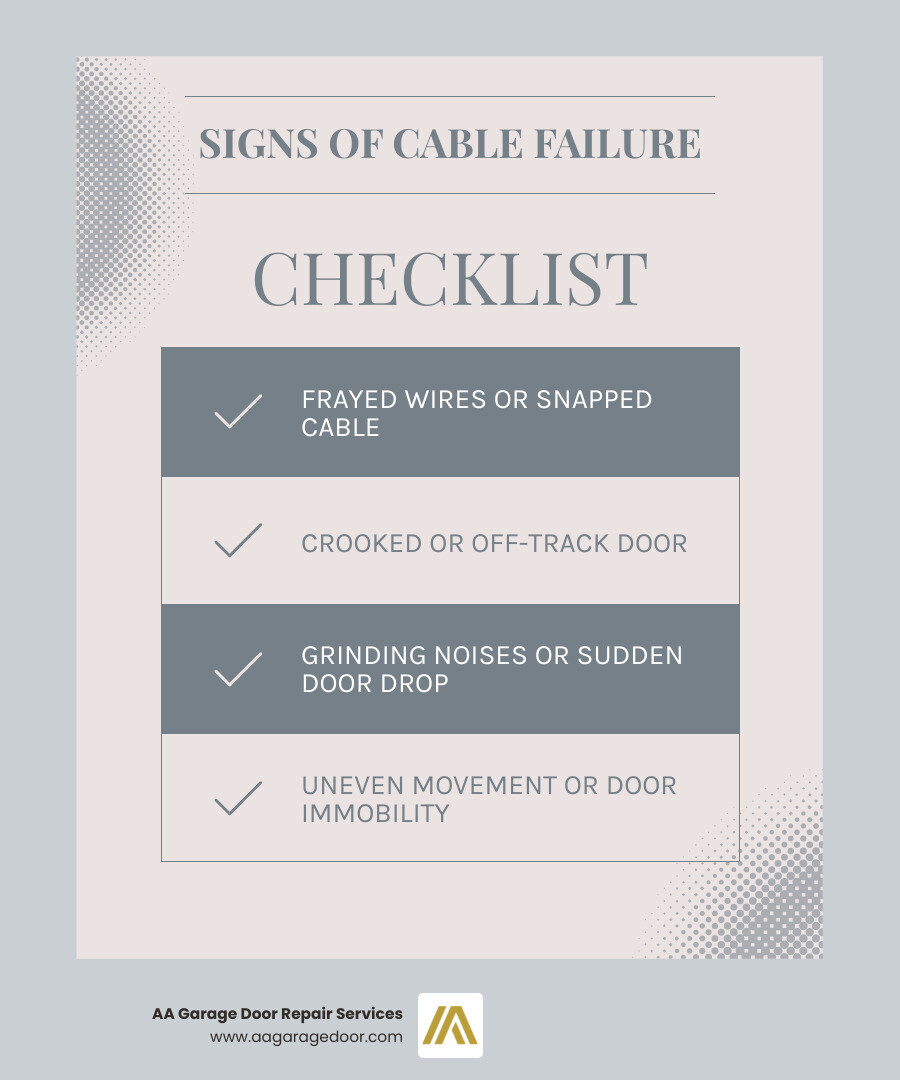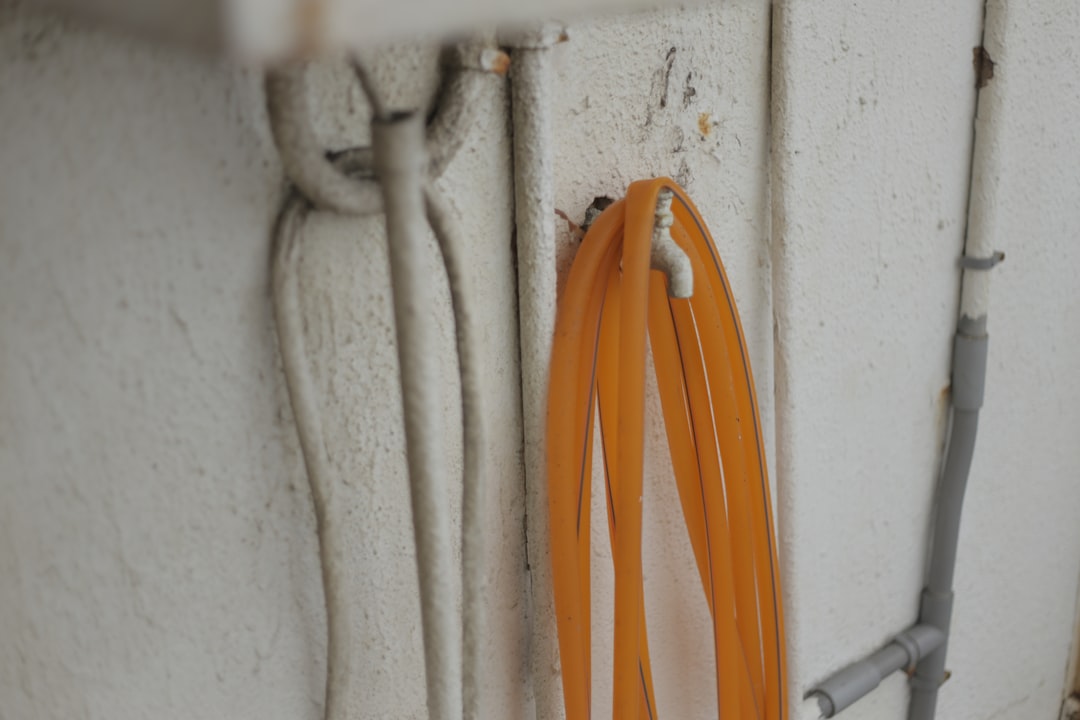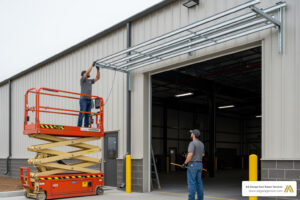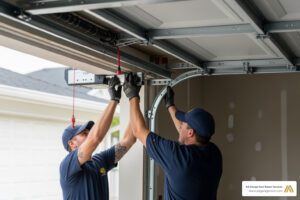Don’t Get Stranded: When Your Garage Door Cable Snaps
Replace garage door cable issues can leave you stranded, unable to get your car out or secure your home. When you hit the garage door button and hear a loud bang followed by a grinding noise, it’s a classic sign: a cable has snapped. Your door might hang crooked, completely immobile. This happens to thousands of homeowners annually, as cables typically fail after 5-7 years. Understanding the repair process is crucial for making safe, smart decisions. For Twin Cities residents needing a quick fix, professional garage door repair services can get your door working safely within hours.
Quick Cable Replacement Overview:
- Cost: $100-$350 professional vs. $15-$50 DIY parts
- Time: 1-2 hours for professionals, 2-4 hours DIY
- Safety Risk: Extremely high due to springs under 400+ lbs of tension
- Recommendation: Professional replacement is advised, especially for torsion systems.
- Both Cables: Always replace as a pair for balance.
Garage door cables operate under extreme tension. While a DIY replacement might seem simple, a single mistake can lead to serious injury or costly damage. I’m David Sands, owner of AA Garage Door LLC. With over 23 years of experience serving Minnesota and Wisconsin, I’ve seen the dangerous aftermath of DIY repairs. This guide will explain when you can safely replace garage door cable systems and when to call a professional.

Is Your Garage Door Cable Failing? Signs and Causes
Your garage door often gives warning signs before a cable fails completely. Knowing what to look for can help you avoid getting stuck with a broken door.
Signs of a Failing Cable
- Frayed Wires: Look closely at the cables. If you see individual strands breaking away from the main wire, it’s a clear sign of wear.
- Snapped Cable: The most obvious sign is a loud bang, after which the door will be immobile or hang crooked.
- Crooked or Off-Track Door: If one cable is damaged, the door loses tension on one side, causing it to hang unevenly or jump off its tracks.
- Grinding Noises: Scraping or grinding sounds often mean a cable is rubbing against something or not winding correctly on its drum.
- Sudden Door Drops: If the door crashes down after opening partway, you have a serious cable or spring issue that requires immediate attention.
- Uneven Movement: A door that jerks or stutters while moving points to a problem with the lifting mechanism.
Common Causes of Cable Failure
Cables don’t last forever, and several factors contribute to their eventual failure:
- Wear and Tear: The average cable lasts 5-7 years. Constant movement, friction, and stress take their toll.
- Moisture and Corrosion: Garages can be humid, and steel cables are susceptible to rust, which weakens them from the inside out.
- Friction and Misalignment: Worn pulleys, misaligned tracks, or obstructions can cause cables to fray and snap prematurely.
- Improper Tension & Weak Springs: Springs do the heavy lifting. If they are weak or improperly tensioned, the cables take on extra strain, accelerating wear. Learn about why damaged springs need professional replacement to prevent this cascade of failures.
- Poor Installation: Incorrectly sized or improperly installed cables will fail much sooner than they should.
Addressing the root cause is just as important as replacing the cable itself. We recommend a professional inspection at least once a year to catch these issues early.
Safety First: Essential Precautions and Tools
Before attempting any repair, understand that garage door systems are dangerous. The springs are under extreme tension, and the door itself can weigh up to 400 pounds. A mistake can lead to severe injury. This is why some “repairs are best left to professionals.”
Essential Safety Precautions
- Disconnect Power: Always unplug the garage door opener before starting work.
- Secure the Door: Clamp the door securely to the tracks to prevent it from falling. If it’s open, clamp it open. If closed, clamp it closed.
- Wear Safety Gear: Safety glasses and sturdy work gloves are non-negotiable.
- Respect Spring Tension: Torsion and extension springs store immense energy. Releasing this tension incorrectly is the primary cause of injury. If you have any doubts, call a professional.
[LIST] of Tools You’ll Need
Having the right tools is critical. Do not improvise.
- Winding Bars: For torsion springs only. Never use screwdrivers.
- Locking Pliers or C-clamps: To secure the door and torsion shaft.
- Socket Wrench Set: For bolts and set screws.
- New Garage Door Cables: Correct length and gauge for your door.
- Sturdy Ladder
- Wire Cutters
- A good pair of pliers
- Measuring Tape
- Safety Glasses and Work Gloves
How to Replace Garage Door Cable on a Torsion Spring System
Replacing a cable on a torsion spring system is one of the most hazardous DIY repairs due to the immense tension in the springs mounted above the door. We cannot overstate the need for extreme caution.
Understanding the Torsion System Components
Key parts include the torsion springs, winding cones (where you adjust tension), cable drums (where cables wrap), and bottom brackets (where cables attach to the door).
Step-by-Step Torsion Cable Replacement
Disclaimer: This is a dangerous procedure. We strongly recommend professional service for torsion systems. These steps are for informational purposes only.
- De-tension the Springs: This is the most critical step. With the door closed, insert a winding bar into the winding cone. While holding it firmly, loosen the set screws. Unwind the spring a quarter turn at a time, using two bars to maintain control. Repeat until all tension is gone.
- Secure the Torsion Tube: Clamp the torsion tube to the center bracket to prevent it from rotating.
- Loosen the Drums: Loosen the set screws on both cable drums so they can spin freely.
- Replace the Cables: Unspool and detach the old cable from the drum and bottom bracket. Install the new cable by attaching it to the bottom bracket first, then winding it tightly onto the drum’s grooves.
- Tighten the Drums: Ensure the cables are equally taut, then tighten the set screws on both drums.
- Re-tension the Springs: Carefully rewind the springs the exact same number of turns you unwound them. Tighten the set screws on the winding cone securely.
- Test Balance: Remove all clamps. Manually lift the door halfway. It should stay in place. If it falls, add a quarter turn of tension. If it rises, remove a quarter turn. Adjust both springs equally.
- Final Test: Reconnect the opener and test the door’s operation.
How to Replace Garage Door Cable on an Extension Spring System
Replacing a cable on an extension spring system is generally less dangerous than on a torsion system, but still requires great care. These springs run along the horizontal tracks and stretch to lift the door.
Understanding the Extension System Components
Key parts include the extension springs, pulleys the cables run over, and safety cables that run through the springs to contain them if they break.
Step-by-Step Extension Cable Replacement
- Open and Secure the Door: Unplug the opener. Open the door fully and secure it by placing C-clamps on both vertical tracks, directly under the bottom rollers. This is critical to prevent the door from falling.
- Release Tension: With the door open, the springs are relaxed. Carefully disconnect the spring from the track hanger to fully release any remaining tension on the cable.
- Remove Old Cable: Detach the old cable from the bottom bracket and unthread it from the pulley system.
- Install New Cable: Attach the new cable to the bottom bracket, thread it over the pulley, and connect it to the extension spring’s attachment point.
- Reconnect the Spring: Reattach the spring to the track hanger. Ensure the safety cable is properly threaded through the spring and secured.
- Repeat on the Other Side: Always replace both cables to ensure the door remains balanced.
- Test the Door: Remove the clamps and manually lower the door. It should move smoothly. If it’s uneven, you may need to adjust the spring tension.
- Final Check: Reconnect the opener and test the automatic operation.
DIY vs. Professional Replacement: A Cost and Risk Analysis
When a cable snaps, the choice between DIY and professional repair comes down to cost versus risk. While DIY parts are cheap ($15-$50), the potential for disaster is high.
The Risks of a DIY Garage Door Cable Replacement
This isn’t a simple home repair. The risks are severe:
- High-Tension Springs: Torsion springs store enough force to cause serious injury or death if they release unexpectedly.
- Sudden Door Drops: A 300+ pound door can fall if not secured properly, acting like a guillotine.
- Incorrect Installation: Using the wrong parts or improper tensioning can lead to another failure and damage other components, turning a $50 job into an $800 one.
For a deeper dive into what professional repairs actually cost, check out our breakdown of garage door repair costs.
| Feature | DIY Cable Replacement | Professional Cable Replacement |
|---|---|---|
| Cost | Parts: $15-50 (cables only) Tools: $50-150+ (if you don’t own them) |
Average Total: $225 (range $100-$350) Labor: $75-150 per hour Emergency Service: Available 24/7 |
| Time | 3-6 hours (first-timers often longer) | 1-2 hours |
| Safety | Extremely High Risk: Potential for severe injury/death | Low Risk: Trained technicians with proper equipment |
| Tools | Winding bars, C-clamps, socket set, ladder, safety gear | Specialized professional-grade tools included |
| Expertise | Requires research, mechanical skills, and luck | Years of training and hands-on experience |
| Warranty | None – you own all problems | Parts and labor warranty included |
| Outcome | High risk of improper installation or injury | Guaranteed correct installation and safe operation |
When to Call a Professional in St. Paul
We strongly advise calling a professional, especially if:
- You have a torsion spring system. The danger is too high for DIY.
- You are unsure of the cause of the failure.
- You lack the proper tools, especially winding bars.
- The door is heavily damaged with bent panels or tracks.
For residents in St. Paul, Minneapolis, and the Twin Cities area, our team offers 24/7 emergency service. Your safety is worth more than the few dollars you might save. When you need guaranteed results, get a quote for your garage door cable repair or call us at (651) 702-1420.
Frequently Asked Questions about Garage Door Cables
Here are answers to the most common questions we get about garage door cables.
Should I replace both garage door cables at the same time?
Yes, always. Both cables have endured the same amount of wear. If one has failed, the other is likely not far behind. Replacing them in pairs ensures the door operates with balanced tension, preventing further strain on the opener and other components. It’s safer and more cost-effective in the long run.
How long do garage door cables last?
Typically, cables last 5 to 7 years. However, this lifespan depends on several factors:
- Usage: More frequent use means faster wear.
- Climate: Minnesota’s humidity and temperature swings can cause rust and fatigue.
- Maintenance: A well-maintained and properly balanced door puts less stress on the cables.
Regular visual inspections for fraying or rust can help you plan for a replacement before it becomes an emergency.
Can garage door cables be repaired, or do they always need to be replaced?
Damaged cables must always be replaced. They cannot be safely repaired. Any attempt to splice or patch a frayed, rusted, or kinked cable creates a weak point that will fail under the immense tension of the door system. The risk of property damage or serious injury is far too high. Replacement is the only safe and reliable solution.
Conclusion: Keep Your Door Running Smoothly
Replacing a garage door cable is a serious repair where safety must be the top priority. While this guide outlines the steps, the immense tension in the springs makes it a dangerous task for the inexperienced.
Regular visual checks for fraying or rust are your best defense against a sudden failure. When a cable does snap, remember the risks involved with a DIY repair, especially with torsion spring systems. What seems like a simple parts replacement can quickly lead to costly damage or serious injury.
If you’re facing a snapped cable or have noticed any warning signs, don’t hesitate to seek professional help. The expert team at AA Garage Door Repair Services has served Twin Cities and Western Wisconsin homeowners since 2001. We offer 24/7 emergency service with transparent pricing and the peace of mind that comes from professional expertise. We’ll ensure the job is done right by assessing the entire system and replacing components in pairs for balanced, long-lasting operation.
Let us help you get your garage door running smoothly and safely again. Schedule your service online today to restore your door’s seamless operation.








